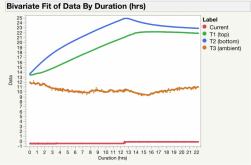ProbablyFreudian slip? My daughter lives/works in Santa Rosa. I'm going to have to start telling her she lives in/near the "bat area".
I think your heat loss calculation is off a bit. I'd need to double check this, but on first blush: You are using the American "R" value which doesn't have units that get you to Watt hours.
I got my definition:

from here: https://en.m.wikipedia.org/wiki/R-value_(insulation)
If that’s not the correct R Val definition to use with the foam insulation we purchase at Home Depot or for soft wood, I appreciate an education.
Our cellars here in the Bat AreaYou want to use the metric "RSI" value, which is simply R / 5.678. So your RSI value would be 1.06/5.678 = 0.1866854 °C*m²/Watt. Dividing your 10°C differential by this RSI value gives you 10/0.1866854 = 53.566 W/m². Multiply that by your area of 0.76m², and you get 40.7W, or 977Wh/day. That seems high to me, so maybe my calculation is wrong too!
You are right that increasing the R value 6 by using foam will decrease the Wh by the ratio 1.06/6, so 40.7W would go down to 7.19W, or 172Wh/day.
You say "cellar temperature" is constant 65°F, but from all the rest I assume you are NOT putting your batteries below grade (in the cellar). If you are, you have no calculating to do!
Before I get to carried away with a heat pad, etc, I’ll confirm how my cells perform at 50F - unless there is a significant drop-off in capacity (as I suspect), I’ll skip the heat pad and just focus on insulating the cells to make use of the heat generated through the charge/discharge cycle...
Like I said, I haven't been counting the heat generated by the cells, and now you are pointing out heat generated by the buss bars. I'll have to noodle on that a bit. You are using 4 mOhm, and I would guess good bus bars are way less than that. I guess I need to go do some more research!
My estimates were 0.25 mOhm of internal resistance + 0.05 mOhm of resistance through each busbar + another 0.2 mOhms of contact resistance per cell (0.1 mOhms per Busbar-terminal contact).
0.45 mOhms / cell x 8 cells = 4 mOhms.
The easiest way to measure the resistance that matters once you have your battery is to use the R=dV/dI method:
Measure first voltage (V1) at a first lower current such as 10A or 20A (I1)
Now crank up current to a higher level like 50A or 80A (I2) and measure second voltage V2.
deltaV = V1 - V2
deltaI = I2 - I1
Rbat = deltaV / deltaI
All instantaneous lost voltage when current increases is from IR losses through cells, busbars, and connections, and all of that IR loss is translated to I^2R Watts of heat generated...
(obviously, over time, increased current also results in voltage drop due to cells being discharged, which is why it is important to get an immediate / instantaneously voltage measurement as soon as current has increased...).



